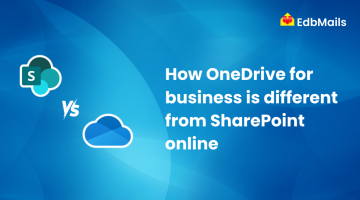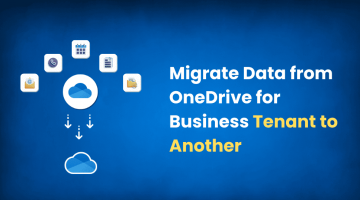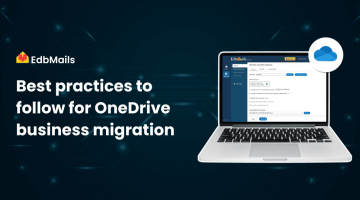OneDrive for Business is a widely used cloud-based storage platform from Microsoft that enables secure file storage, sharing, and collaboration from virtually anywhere. Organizations of all sizes rely on it to manage business-critical files and collaborate across teams. However, when it comes to OneDrive migration whether due to mergers, acquisitions, domain changes, or Office 365 tenant-to-tenant moves, ensuring data integrity, security, and consistency becomes a top priority.

While Microsoft provides native options for migrating OneDrive data, these often come with limitations such as throttling, file size restrictions, bandwidth interruptions, and a lack of flexibility. Manual approaches may work for small-scale moves but are rarely feasible for enterprises managing terabytes of files and thousands of users. This is where a specialized OneDrive migration tool plays a critical role.
A reliable migration solution should not only handle large volumes of data seamlessly but also ensure zero data loss, minimal user impact, and complete preservation of metadata. With several tools available in the market, it can be challenging to choose the right one. Below are the 11 essential features you must consider when selecting a OneDrive migration tool.
1. Preserve Source Folder Hierarchy
The tool must maintain the exact source folder and file hierarchy during migration. This ensures that end users find their data in the same structure as before, avoiding confusion and reducing post-migration troubleshooting. A well-structured migration should deliver a mirror copy of the source environment.
2. Easy-to-Use Interface
A migration tool should offer a simple, intuitive dashboard that both IT admins and non-technical users can operate without extensive training. Complex scripting or coding-based tools slow down adoption and increase the chance of human error.
3. No User Downtime During Migration
End users should be able to continue working on their OneDrive accounts even while migration is in progress. A good tool runs the process in the background without locking files or interrupting user productivity.
4. Zero Data Loss Guarantee
Data loss during migration can be disastrous for any business. The chosen tool must ensure 100% data security and reliability, transferring every file without corruption or compromise. Built-in validation mechanisms are essential to confirm that the data at the destination matches the source.
5. Direct Migration Without Storing Data Midway
Security should be the top concern. The tool must migrate data directly from source to destination without storing files temporarily in third-party servers or external storage. This eliminates unnecessary risks and ensures compliance with data privacy policies.
6. No File Size or Data Limits
Enterprise migrations often involve very large files, libraries, or even terabytes of content. Your migration solution should handle these volumes without restrictions, throttling, or timeouts. Support for large-scale data transfers ensures scalability as your organization grows.
7. Support for Same or Cross-Domain Migration
Business needs often require moving OneDrive data either within the same domain or across different domains—for example, during mergers or tenant consolidations. The tool must support both scenarios seamlessly while preserving all file and sharing permissions.
8. Incremental Migration to Prevent Duplicates
Incremental migration is an important feature that allows only new or modified files to be migrated after the initial transfer. This avoids duplicate content at the destination, reduces processing time, and ensures efficient migration during staged moves.
9. Granular Migration with Folder-Level Selection
Not every migration requires moving the entire OneDrive account. The tool should allow granular migration, selecting specific folders, files, or libraries to migrate. This is especially useful when organizations only want to transfer relevant business data and exclude unnecessary files.
10. Preserve Metadata and File Properties
Metadata such as Created Date, Modified Date, Modified By, File Owner, and Permissions are critical for business workflows. The migration tool must retain all metadata intact so that users see the same file information in the new environment. Any loss or modification of metadata can create compliance and audit challenges.
11. Generate Detailed Migration Reports
Transparency is key. A reliable migration tool should provide comprehensive reports and logs that detail which files were migrated, skipped, or failed. These reports help administrators validate success, troubleshoot errors, and maintain compliance records for audits.
Why Choose EdbMails OneDrive Migration Tool?
EdbMails OneDrive Migration is purpose-built to meet all the above requirements. As a Microsoft-certified partner with ISO 27001:2013 certification, EdbMails provides a highly secure, reliable, and scalable solution for organizations of all sizes.
Key highlights of EdbMails OneDrive Migration Tool include:
- Direct tenant-to-tenant OneDrive migration without intermediaries.
- Support for large-scale enterprise migrations with no size limits.
- Advanced incremental and selective migration features.
- Preservation of folder hierarchy, metadata, and file permissions.
- End-to-end encryption using OAuth 2.0 and TLS.
- Detailed migration reports for auditing and compliance.
Whether you’re moving a single user’s files or performing a complete enterprise-wide OneDrive tenant migration, EdbMails helps you achieve it securely and with minimal downtime.
For a detailed walkthrough, check out the official EdbMails OneDrive Migration Video Guide.
Conclusion
While native methods may work for small-scale moves, they often introduce risks such as throttling, downtime, and file size limitations. For organizations looking to migrate OneDrive data securely, quickly, and without data loss, investing in a professional OneDrive migration tool is the best approach.By focusing on the 11 features outlined above, folder hierarchy preservation, metadata retention, incremental migration, detailed reports, and strong security, you can ensure a smooth transition with minimal impact on end users. Among the available solutions, EdbMails OneDrive Migration Tool stands out as a robust choice for enterprises seeking reliability, compliance, and scalability.



